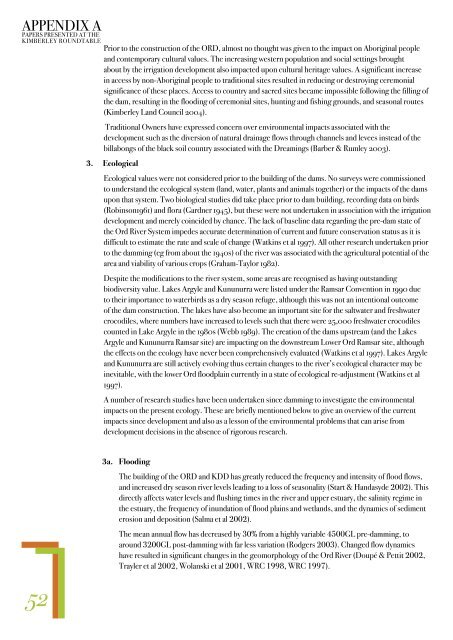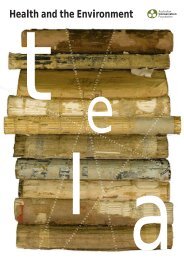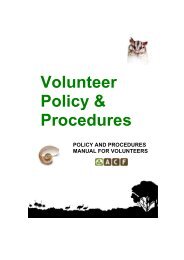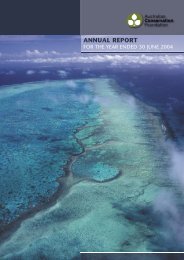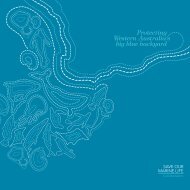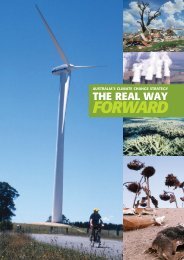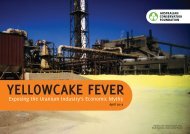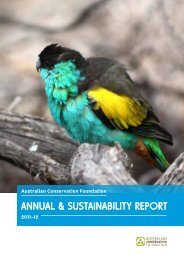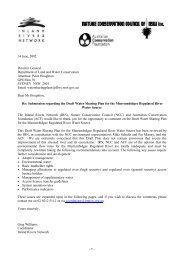Kimberley Appropriate Economics Interim Report - Australian ...
Kimberley Appropriate Economics Interim Report - Australian ...
Kimberley Appropriate Economics Interim Report - Australian ...
Create successful ePaper yourself
Turn your PDF publications into a flip-book with our unique Google optimized e-Paper software.
Prior to the construction of the ORD, almost no thought was given to the impact on Aboriginal people<br />
and contemporary cultural values. The increasing western population and social settings brought<br />
about by the irrigation development also impacted upon cultural heritage values. A significant increase<br />
in access by non-Aboriginal people to traditional sites resulted in reducing or destroying ceremonial<br />
significance of these places. Access to country and sacred sites became impossible following the filling of<br />
the dam, resulting in the flooding of ceremonial sites, hunting and fishing grounds, and seasonal routes<br />
(<strong>Kimberley</strong> Land Council 2004).<br />
Traditional Owners have expressed concern over environmental impacts associated with the<br />
development such as the diversion of natural drainage flows through channels and levees instead of the<br />
billabongs of the black soil country associated with the Dreamings (Barber & Rumley 2003).<br />
3. Ecological<br />
Ecological values were not considered prior to the building of the dams. No surveys were commissioned<br />
to understand the ecological system (land, water, plants and animals together) or the impacts of the dams<br />
upon that system. Two biological studies did take place prior to dam building, recording data on birds<br />
(Robinson1961) and flora (Gardner 1945), but these were not undertaken in association with the irrigation<br />
development and merely coincided by chance. The lack of baseline data regarding the pre-dam state of<br />
the Ord River System impedes accurate determination of current and future conservation status as it is<br />
difficult to estimate the rate and scale of change (Watkins et al 1997). All other research undertaken prior<br />
to the damming (eg from about the 1940s) of the river was associated with the agricultural potential of the<br />
area and viability of various crops (Graham-Taylor 1982).<br />
Despite the modifications to the river system, some areas are recognised as having outstanding<br />
biodiversity value. Lakes Argyle and Kununurra were listed under the Ramsar Convention in 1990 due<br />
to their importance to waterbirds as a dry season refuge, although this was not an intentional outcome<br />
of the dam construction. The lakes have also become an important site for the saltwater and freshwater<br />
crocodiles, where numbers have increased to levels such that there were 25,000 freshwater crocodiles<br />
counted in Lake Argyle in the 1980s (Webb 1989). The creation of the dams upstream (and the Lakes<br />
Argyle and Kununurra Ramsar site) are impacting on the downstream Lower Ord Ramsar site, although<br />
the effects on the ecology have never been comprehensively evaluated (Watkins et al 1997). Lakes Argyle<br />
and Kununurra are still actively evolving thus certain changes to the river’s ecological character may be<br />
inevitable, with the lower Ord floodplain currently in a state of ecological re-adjustment (Watkins et al<br />
1997).<br />
A number of research studies have been undertaken since damming to investigate the environmental<br />
impacts on the present ecology. These are briefly mentioned below to give an overview of the current<br />
impacts since development and also as a lesson of the environmental problems that can arise from<br />
development decisions in the absence of rigorous research.<br />
3a. Flooding<br />
The building of the ORD and KDD has greatly reduced the frequency and intensity of flood flows,<br />
and increased dry season river levels leading to a loss of seasonality (Start & Handasyde 2002). This<br />
directly affects water levels and flushing times in the river and upper estuary, the salinity regime in<br />
the estuary, the frequency of inundation of flood plains and wetlands, and the dynamics of sediment<br />
erosion and deposition (Salma et al 2002).<br />
The mean annual flow has decreased by 30% from a highly variable 4500GL pre-damming, to<br />
around 3200GL post-damming with far less variation (Rodgers 2003). Changed flow dynamics<br />
have resulted in significant changes in the geomorphology of the Ord River (Doupé & Pettit 2002,<br />
Trayler et al 2002, Wolanski et al 2001, WRC 1998, WRC 1997).<br />
52


